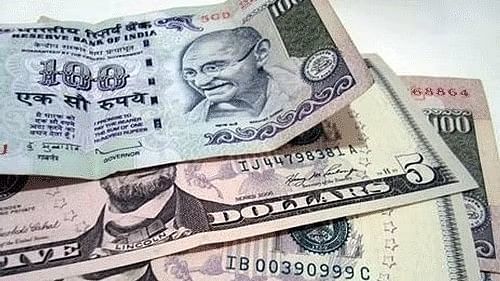
Representative image showing Indian Rupee and US Dollar.
Credit: PTI File Photo
The United States Federal Reserve’s first interest rate cut in more than four years on September 18, 2024, and that too by 50 basis points (bps) was triggered by the recent economic data for the US economy, such as a slowdown in hiring combined with a decline in the inflation rate.
At the press conference, Fed chair Jerome Powell said, “We took all of (the data) and concluded this was the right thing for the economy and the people we serve. Our patient approach has paid dividends – inflation is much closer to our target of 2 per cnet annual rate. The upside risks to inflation have diminished and the upside risks to unemployment have increased”.
However, Powell also clarified that the half-point reduction in the interest rate did not represent any new pattern for the central bank. The decision to cut the rate by 50 bps was not unanimous though, as one governor dissented, preferring a cut of 25 bps. Also, the ‘Summary of Economic Projections’ (SEP) was not very dovish and suggested that the US Fed will cut interest rates gradually over the course of the next year or so.
Recent actions of other central banks
The move by the US Fed followed cuts by other central banks, including those in Europe (the ECB cut rate by 25 bps on September 12), the United Kingdom (the BOE cut rate by 25 bps in early August), and Canada (Bank of Canada cut rate by 25 bps on September 4). Indonesia’s central bank delivered its first rate cut (25 bps) in three years just hours ahead of the US Fed’s action to balance between domestic stability and growth.
Following the US Fed’s action, the Hong Kong Monetary Authority (HKMA) cut rates by 50 bps yesterday for the first time since 2020, as its local currency is pegged to the US dollar.
Will the US Fed’s action spur an immediate reaction across Asia? It is unlikely, as many central banks of the region would like to focus on financial stability and other risks. For example, market participants expect the Bank of Japan to keep borrowing costs unchanged on September 20.
Implications of US Fed action for India
Indian stocks may witness some volatility in the short term due to concerns of a likely global economic slowdown, which might have prompted the US Fed to undertake a larger interest rate cut. However, India’s relatively better economic prospects supported by the ongoing rural recovery during 2024 due to improved water reservoir levels should support the equity outlook in the medium term.
So far as the Indian monetary policy is concerned, the RBI governor has been repeatedly saying that India’s benchmark interest rate will hinge on the future trajectory of inflation, emphasising that month-on-month inflation momentum — whether it’s building up or moderating — will be key to the RBI’s decision-making process. In his recent interview with CNBC, he said “It is not so much about how the inflation is now; we have to look at for the next six months, for the next one year — what is the outlook on inflation”.
While the recent headline CPI inflation for India looks benign at 3.6-3.65 per cent, they have benefitted a great deal from the favourable statistical base. There will be a reversal of this base effect from September-October 2024. Also, the RBI has been refraining from providing forward guidance on interest rates due to the risks associated with an uncertain global environment (rising geopolitical stresses) and climate-related events.
According to the RBI’s internal study, climate events have become the dominant reason for the rise in food prices. In the period 2016 to 2020, average food inflation was 2.9 per cent. This has more than doubled in the 2020s to an average of 6.3 per cent due to erratic weather and extreme climatic events.
Another fear is if Donald Trump comes to power again in the US, he will reignite inflationary pressures in the US as well as in the global economy. Trump’s promises around tax cuts, tariffs (protectionism) and immigration (loss of cheap labour to the US) could lead to serious inflation, and may again create global supply chain disruptions. Another concern for the RBI will be to protect the Indian rupee and India’s financial stability from extreme volatility amid divergent growth scenarios and monetary policies of different nations.
Moreover, a new monetary policy committee (MPC) will be constituted in India next month, with three new external members replacing those whose tenures have ended after four years. The new MPC’s assessment of the evolving mix of domestic growth and inflation will decide the tone of upcoming monetary policy rather than the US Fed’s action.
Easing of monetary policy is certainly not a given for India at this point.
(Rupa Rege Nitsure is a research economist who has worked as chief economist in the BFSI space for more than three decades.)
(Disclaimer: The views expressed above are the author's own. They do not necessarily reflect the views of DH.)